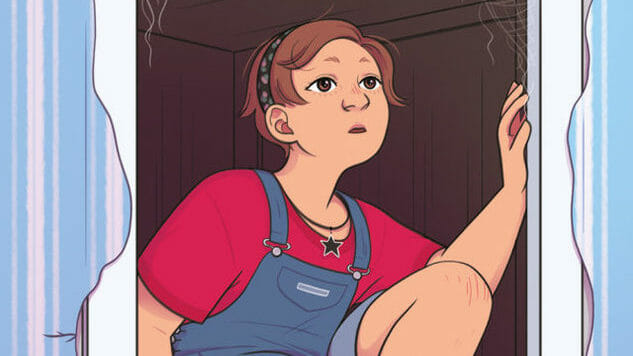Sincerely, Harriet Cartoonist Sarah Winifred Searle Talks Old Buildings & Intersectionality
Art by Sarah Winifred Searle
Sarah Winifred Searle’s upcoming middle-grade graphic novel Sincerely, Harriet, arriving from publisher Graphic Universe next May, fits comfortably next to some of the best-known titles for readers that age. It stars the titular Harriet, trapped in the awkward age that’s just on the cusp of adulthood, striving for independence but not quite equipped for it yet. When the book opens, Harriet is settling into her new home in Chicago with her parents, avoiding summer reading and her downstairs neighbor. As the story unfolds and the reader learns more about Harriet and the circumstances that led her family to move, it becomes clear that her relatable struggles aren’t just the average worries of a teenage girl in a new situation.
Sincerely, Harriet is kind without sugarcoating challenges or offering up empty platitudes. It trusts the readers to understand that growing up can be hard, and that the things that make it even harder for you can be invisible to others. It’s the sort of book that can help young readers feel less alone as they face some of the same struggles, and doesn’t minimize the way kids feel. It’s also a graceful lesson in intersectionality, layering in multiple identities to create a character and a world that are rich and full of life so organically that it doesn’t feel like an afterschool special, just one girl’s authentic story. As Harriet learns about her new city, her new neighbor and herself, the book offers affirmations and affection that both Harriet and the reader may need. It’s the perfect addition to a collection that includes the likes of Judy Blume and Raina Telgemeier, and Paste was thrilled to chat with Searle to learn more about it.
![]()

Sincerely, Harriet Cover Art by Sarah Winifred Searle
Paste: Though it’s far from the only work you’ve done in the last couple of years, I think a lot of your fans may be more familiar with the stories you did for Fresh Romance and The Nib; much of your previous work has been for adults. What in particular appealed to you about creating a middle grade book like Sincerely, Harriet?
Sarah Winifred Searle: I read an interview with Maurice Sendak a while back where someone asked why he made work for kids. His response (poorly paraphrased by yours truly) was something like, “I don’t. I make books and then they tell me they’re for children.” That’s pretty much what’s happened with Sincerely, Harriet and most of my other work. I find seeds of inspiration in history and media and people’s experiences, and a story begins to take shape. My agent and editors help me figure out where the characters and themes sit, market-wise, and we gently mold these ideas into something more polished. I never set out to become a middle-grade author, but since realizing that’s where Harriet belongs, I’ve grown such an appreciation for this market and its special challenges and rewards.
Paste: Harriet is a relatable and accessible protagonist, a young girl feeling isolated by her arrival to a new home in a new city. One of the things that’s really appealing about the book is the specificity you use to describe her life, with details that add texture and depth. Did Harriet form slowly in your head, or did she arrive fully formed with all those details in place?
Searle: It honestly feels like she sprouted fully formed from my head, Athena-style. She’s inspired by visceral memories of what growing up in the ‘90s was like, and how the stories I loved shaped my view of the world. For example, she can’t get enough of the movie Beetlejuice, and she wants her life to reflect that. All of this is informed by her environment and the people who surround her, which gave me a great opportunity to play with the house as a character in itself.
Paste: Harriet’s new home, the kind of older multi-unit building that’s especially common in big cities, has a lot of details of its own. You’ve worked on period pieces as well—is there something about older buildings that attracts your creative attention?
Searle: Definitely! I’ve spent my life moving through a series of weird old buildings with apartments carved creatively out of previously single-family homes, locked doors that lead to nowhere, and even a couple converted hotels with mysterious walled-over windows and decommissioned century-old bells. I’ve always been into history, and I’ve always wished I could know the full lives of the places I’ve lived. To indulge that curiosity, I drew two different floor plans for Sincerely, Harriet while scripting it: one version from when Pearl’s children were young and they utilized the entire townhouse, and then another after they turned the second floor into an apartment on a slim budget. I like to think the quirks left behind through its transformation sparked Harriet’s imagination just as much as it did mine while growing up.
Paste: Old houses like the one that Harriet’s family move into are often used as a setting for horror stories, but in this book the house has history and memories but doesn’t feel frightening or unwelcoming. How did you keep the setting from becoming spooky instead of emotional?
-

-

-

-

-

-

-

-

-

-

-

-

-

-

-

-

-

-

-

-

-

-

-

-

-

-

-

-

-

-

-

-

-

-

-

-

-

-

-

-









































